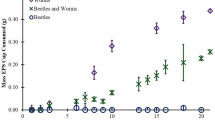Abstract
We determined the food source and water balance properties of the hissing-cockroach mite, Gromphadorholaelaps schaeferi. The food source for mites was identified using Evans blue dye by direct injection into a fasting host cockroach, Gromphadorhina portentosa, or by incorporation into cockroach food. No coloration was observed in mites on dye-injected cockroaches, but coloration was present in mites when only the food for the cockroaches had been stained. Thus, the mites are scavengers of cockroach food, and are not parasitic as previously thought. Our results demonstrate that the mites can absorb water from the air anywhere between 0.84 and 0.93 a v (%RH/100), and wax-block experiments revealed that the mouth is the site of uptake. The mites are normally clumped together on the host, typically in between the cockroach's legs and around the spiracles. Water loss rates for mites in groups (0.16% h-1) were far lower than for isolated mites (0.30% h-1), suggesting a ‘group effect’ with regard to water balance. Above the transition temperature of 30°C rate of water loss was rapid. The sites occupied by mites on the cockroach's body seem to be highly specific for feeding and absorption of water vapour.
Similar content being viewed by others
References
Arlian, L.G. 1975. Water exchange and effect of water vapour activity on metabolic rate in the house dust mite, Dermatophagoides. J. Insect Physiol. 21: 1439–1442.
Arlian, L.G. and Ekstrand, I.A. 1975. Water balance in Drosophila pseudoobscura, and its ecological implications. Ann. Entomol. Soc. Am. 68: 827–832.
Arlian, L.G. and Veselica, M.M. 1979. Water balance in insects and mites. Comp. Biochem. Phys., 64: 191–200.
Bruce, W.A. and Needham, G.R. 1994. Effects of temperature and humidity on the water balance of Varroa jacobsoni (Acari: Varroidae). In Acarology IX: proceedings, G.R. Needham, D.J. Horn and R. Mitchell (eds.). Ohio Biological Survey, Columbus, in press.
Denlinger, D.L. 1994. The beetle tree. Am. Entomol. 40: 168–171.
Grassé, P.P. and Chauvin, R. 1944. L'effet de groupe et la survie des neutres dans les sociétés d'insects. Rev. Sci. 82: 461–464.
Hadley, N.F. 1994. Water Relations of Terrestrial Arthropods. Academic Press, New York.
Hair, J.A., Sauer, J.R., and Durham, K.A. 1975. Water balance and humidity preference in three species of ticks. J. Med. Entomol. 12: 37–46.
Johnson, C.G. 1940. The maintenance of high atmospheric humidities for entomological work with glycerol-water mixtures. Ann. Appl. Biol. 27: 295–299.
Knülle, W. 1962. Die Abhängigkeit der Luftfeuchtreaktionen der Mehlmilbe (Acarus siro) vom Wassergehalt des Körpers. Z. Vergl. Physiol. 45: 233–246.
Knülle, W. and Rudolph, D. 1982. Humidity relationships and water balance in ticks. In Physiology of ticks, F.D. Obenchain and R. Galun (eds.), pp. 43–70. Pergamon Press, Oxford.
Lees, A.D. 1947. Transpiration and the structure of the epicuticle in ticks. J. Exp. Biol. 23: 379–410.
Machin, J. and Lampert, G.J. 1989. Energetics of water diffusion through the cuticular water barrier of Periplaneta: the effect of temperature, revisited. J. Insect Phys. 5: 437–445.
Needham, G.R. and Teel, P.D. 1991. Off-host physiological ecology of Ixodid ticks. Ann. Rev. Entomol. 41: 232–237.
Noble-Nesbitt, J. 1970. Water uptake from subsaturated atmospheres: its site in insects. Nature 225: 753–755.
O'Donnell, M.J. and Machin, J. 1988. Water vapour absorption by terrestrial organisms. Adv. Comp. Environ. Phys. 2: 47–90.
Roth, L.M. and Willis, E.R. 1960. The biotic associations of cockroaches. Smithsonian Misc. Collect. 141: 1–470.
Schaefer, C.W. and Peckham, D.B. 1968. Host preference studies on a mite infesting the cockroach Gromphadorhina portentosa. Ann. Entomol. Soc. Am. 61: 1475–1478.
Schmidt, G.D. and Roberts, L.S. 1981. Foundations of Parasitology. C. V. Mosby, St Louis.
Schmidt-Nielsen, K. 1984. Scaling: Why is Animal Size so Important? Cambridge University Press, New York.
Seethaler, H.W., Hnülle, W. and Devine, T.L. 1979. Water vapour intake and body water (3HOH) clearance in the housemite (Glycyphagus domesticus). Acarologia 21: 440–450.
Sigal, M.D. and Arlian, L.G. 1982. Water balance of the social insect Formica exsectoides (Hymenoptera: Formicidae) and its ecological implications. Phys. Zool. 55: 355–366.
Sigal, M.D., Machin, J. and Needham, G.R. 1991. Hyperosmotic oral fluid secretion during active water vapour absorption and during desiccation-induced storage-excretion by the unfed tick Amblyomma americanum. J. Exp. Biol. 157: 585–591.
Sokal, R.R. and Rohlf, F.J. 1981. Biometry. W.H. Freeman, New York.
Till, W.M. 1969. A new laelapine mite from the Madagascar hissing-cockroach, Gromphadorhina portentosa (Schaum). Acarologia 11: 515–523.
Toolson, E.C. 1978. Diffusion of water through the arthropod cuticle: thermodynamic consideration of the transition phenomenon. J. Therm. Biol. 3: 69–73.
Wharton, G.W. 1985. Water balance of insects. In Comprehensive insect physiology, biochemistry and pharmacology, Vol. 4, G.A. Kerkut and L.I. Gilbert (eds.), pp. 565–603. Pergamon Press, Oxford.
Wharton, G.W. and Kanungo, K. 1962. Some effects of temperature and relative humidity on water balance in females of the spiny rat mite, Echinolaelaps echidninus (Acarina: Laelaptidea). Ann. Entomol. Soc. Am. 55: 483–492.
Winston, P.W. and Bates, D.S. 1960. Saturated solutions for the control of humidity in biological research. Ecology 41: 232–237.
Yoder, J.A. and Denlinger, D.L. 1992. Water balance in flesh fly pupae and water vapour absorption associated with diapause. J. Exp. Biol. 157: 273–286.
Yoder, J.A. and Spielman, A. 1993. Differential capacity of larval deer ticks (Ixodes dammini) to imbibe water from subsaturated air. J. Insect Phys. 38: 863–869.
Yoder, J.A., Denlinger, D.L. and Wolda, H. 1992a. Aggregation promotes water conservation during diapause in the tropical fungus beetle, Stenotarsus rotundus. Entomol. Exp. Appl. 63: 203–205.
Yoder, J.A., Dennis, M.W., Denlinger, D.L. and Kolattukudy, P.E. 1992b. Enhancement of diapausing flesh fly puparia with additional hydrocarbons and evidence for alkane biosynthesis by a decarbonylation mechanism. Insect Biochem. Mol. Biol. 22: 237–243.
Yoder, J.A., Rivers, D.B. and Denlinger, D.L. 1994. Water relationships in the ectoparasitoid Nasonia vitripennis during larval diapause. Phys. Entomol. 19: 373–378.
Author information
Authors and Affiliations
Rights and permissions
About this article
Cite this article
Yoder, J.A., Barcelona, J.C. Food and water resources used by the Madagascan hissing-cockroach mite, Gromphadorholaelaps schaeferi . Exp Appl Acarol 19, 259–273 (1995). https://doi.org/10.1007/BF00052618
Issue Date:
DOI: https://doi.org/10.1007/BF00052618




